North Atlantic right whales sit on the edge of extinction, with only about 384 individuals left in 2024. They face deadly threats like vessel strikes and entanglement in fishing gear, which cause injuries and hinder reproduction. Despite some recent population gains, their birth rates remain critically low. To learn how conservation efforts, technology, and policy changes are attempting to save these gentle giants, continue exploring this urgent and impactful story.
Key Takeaways
- North Atlantic right whales are critically endangered, with only around 384 individuals remaining in 2024.
- Low reproductive rates and long intervals between births hinder population recovery efforts.
- Vessel strikes and gear entanglements are leading causes of injury and death for these whales.
- Conservation strategies include vessel speed restrictions, gear modifications, and advanced monitoring technologies.
- Protecting these whales is vital for maintaining marine ecosystem health and biodiversity.
The Current State of North Atlantic Right Whales

Despite recent small increases, North Atlantic right whales remain critically endangered, with an estimated population of around 384 individuals in 2024. You should know this number reflects a slight 2.1% rise from 2023, but the overall trend remains slow and fragile. The population has only modestly recovered from a low of 358 whales in 2020. Reproduction rates are alarmingly low, with just 11 calves born in 2024, far below the needed levels for growth. Many females experience longer intervals between births, and stress from injuries, fishing gear, and vessel strikes hampers recovery. Despite efforts to improve conditions, the species still faces significant threats, and the population’s health remains fragile. The slow upward trend offers cautious hope, but urgent action is still critical.
Signs of Hope: Population Trends and Recovery Efforts
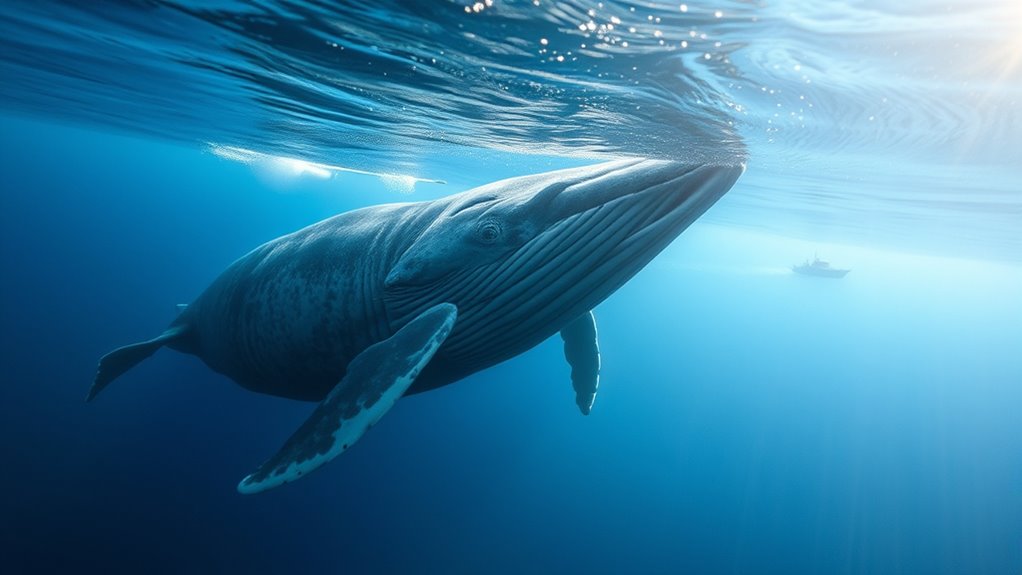
Recent years have shown cautious signs of progress for North Atlantic right whales, with the population slowly edging upward. In 2024, estimates suggest about 384 whales, a 2.1% increase from 2023, after years of decline. While this small growth offers hope, the species remains critically endangered. Key recovery efforts include:
Recent signs of growth give hope, but North Atlantic right whales remain critically endangered.
- Implementing vessel speed regulations and gear modifications to reduce injuries
- Using advanced monitoring tools like AIS to alert mariners
- Strengthening protections through government regulations
- Ongoing research and adaptive management by NOAA and conservation groups
These measures aim to curb human impacts, improve survival, and boost reproduction. Although the population remains fragile, the upward trend shows that targeted efforts can make a difference, providing a glimmer of hope for the future of these iconic giants. Continued conservation strategies are essential to ensure the long-term recovery of this species. Efforts such as marine habitat preservation are vital to providing a safe environment for reproduction and growth. Additionally, increasing public awareness and community engagement can enhance conservation success by fostering support for protective measures. Implementing biodiversity-friendly practices within marine environments can further support the resilience of critical species like the North Atlantic right whale. Advances in population monitoring technologies are also playing a crucial role in tracking recovery progress and guiding future actions.
The Critical Threats: Vessel Strikes and Entanglements
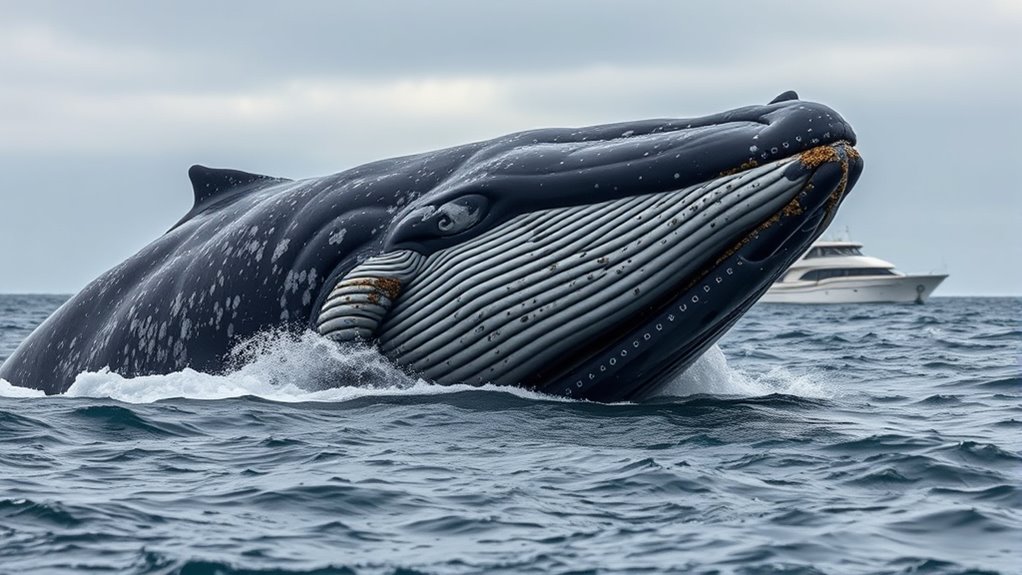
Vessel strikes and gear entanglements are the main threats causing injury and death among North Atlantic right whales. In 2024, researchers recorded multiple fatalities and injuries, highlighting the ongoing danger from human activities. To protect these whales, implementing effective mitigation strategies like vessel speed limits and gear modifications is urgent. Additionally, cybersecurity vulnerabilities during incidents like outages can hinder emergency response efforts and data sharing critical for whale protection. Ensuring the security of data systems is essential for timely intervention and effective conservation measures. Strengthening digital infrastructure can help mitigate risks associated with cybersecurity threats and improve response coordination. Incorporating tuning modifications into vessel systems can also enhance operational safety and reduce collision risks, benefiting both maritime safety and whale conservation. Regular maintenance and inspection of home furnishings, such as heated mattress pads, can prevent electrical failures and ensure safety during use, which is crucial when managing the safety of complex systems involved in conservation efforts.
Rising Collision Incidents
Collision incidents involving North Atlantic right whales have become an increasing concern, with vessel strikes and entanglements now leading causes of injury and mortality. These incidents threaten the small, fragile population and hinder recovery efforts. In 2024, researchers recorded five whale deaths, 16 entanglements (10 with gear attached), and eight vessel strikes. So far in 2025, no deaths but recent injuries include one entanglement and one vessel strike. Many whales remain entangled from previous years, complicating impact assessments. To reduce these threats, efforts focus on:
- Implementing vessel speed restrictions in critical habitats
- Modifying fishing gear to prevent entanglements
- Increasing patrols to identify and free entangled whales
- Enhancing monitoring systems like AIS to alert mariners
Efforts are also underway to improve total‑cost clarity for conservation measures and ensure sustainable solutions. Swift action is essential to prevent further injuries and save this endangered species. Additionally, developing effective mitigation strategies is crucial for long-term conservation success.
Gear Entanglement Dangers
Gear entanglements pose a serious threat to North Atlantic right whales, often resulting in injury or death that hampers their chances of recovery. When whales become tangled in fishing gear, they struggle to swim, feed, and breathe, leading to exhaustion, injuries, or drowning. Many entanglements are associated with vertical lines used in lobster, crab, and gillnet fisheries. These lines can remain in the water for years, increasing the risk of accidental contact. In 2024, 16 whales were entangled, with 10 still carrying gear, illustrating the ongoing danger. Despite efforts to modify gear and implement whale-safe regulations, entanglements remain a significant obstacle. Reducing gear-related injuries requires stricter gear controls, better gear marking, and rapid disentanglement efforts to improve whale survival chances.
Mitigation Strategies Needed
To effectively reduce the deadly impacts of vessel strikes and entanglements, all-encompassing mitigation strategies are essential. You need targeted actions to protect these fragile whales from human harm. Key strategies include:
- Implementing vessel speed restrictions in critical habitats
- Using dynamic management tools like real-time whale tracking alerts
- Modifying fishing gear to reduce entanglement risks
- Increasing enforcement of existing regulations and expanding protected zones
These measures help minimize collisions and gear interactions, giving whales a better chance to recover. Public awareness campaigns and collaboration with maritime industries are essential to ensure compliance and effectiveness. Without comprehensive efforts, vessel strikes and entanglements will continue to threaten the species’ survival. Strong, adaptive strategies are crucial for turning the tide in their favor. Effective mitigation techniques are also vital for long-term conservation success, especially when informed by scientific research that identifies high-risk areas and behaviors. Additionally, implementing monitoring technologies can provide real-time data to adapt management measures more swiftly and accurately.
Challenges in Reproduction and Calving Rates
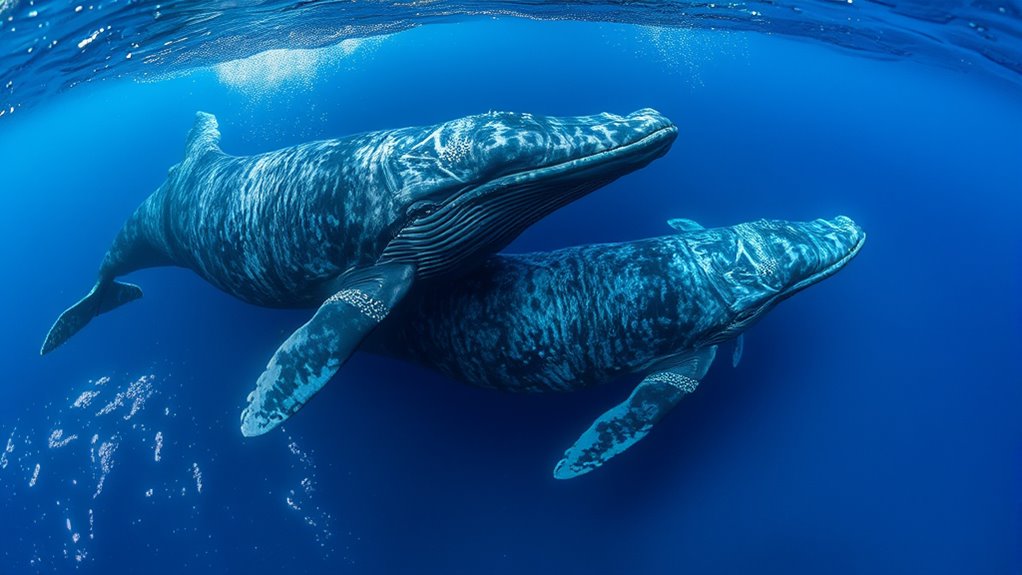
Reproductive and calving rates in North Atlantic right whales are alarmingly low, hindering the species’ recovery. Only 11 calves were born during the 2024-2025 season, far below the needed numbers for population growth. Female whales now have longer intervals between births, averaging 6 to 10 years, instead of the healthy 3-year cycle. This decline is linked to injuries, stress from entanglements, vessel strikes, and environmental changes, which impair reproductive health. With about 70 reproductive females remaining, the current calving rate is insufficient to reverse population decline. To recover, the whales need at least 50 calves annually over many years. Without significant improvements, low reproduction will continue to threaten their survival and hinder progress toward recovery.
Innovative Strategies for Conservation and Protection

You can play a role in conservation by supporting new technological tools like AIS monitoring that alert mariners to whale presence, helping reduce vessel strikes. Policy innovations, such as stricter speed limits and gear regulations, are also critical for protecting these whales. Combining technology with strong regulations offers a powerful approach to safeguard and recover this endangered species. Additionally, implementing portable power solutions can support ongoing research and monitoring efforts in remote areas. Proper management of cookies and privacy settings ensures that data collected during research is handled responsibly and ethically, supporting transparency and trust in conservation efforts.
Technological Monitoring Advances
Recent technological advances have revolutionized how conservationists monitor and protect North Atlantic right whales. You now have tools that detect whales more quickly and accurately, enabling faster responses. For example:
- Satellite tagging tracks whale movements in real-time, revealing migration patterns and critical habitats.
- Acoustic monitoring networks detect whale calls over vast areas, alerting ships and researchers to their presence.
- Drone technology provides high-resolution images of whales and their surroundings, identifying entanglements or injuries early.
- Automated data analysis tools efficiently process large datasets, helping scientists identify trends and threats more rapidly.
- Incorporating AI security technologies enhances data protection and analysis, ensuring sensitive information remains secure as you manage vast amounts of conservation data.
- Additionally, real-time data processing allows for immediate decision-making, which is crucial in emergency situations involving endangered whales.
- The integration of advanced tracking technologies further improves our ability to monitor whale populations with greater precision and less invasive methods.
- The use of machine learning algorithms optimizes pattern recognition in complex datasets, supporting proactive conservation strategies.
- Continuous improvements in sensor technology provide more detailed environmental data, enabling a comprehensive understanding of whale habitats and threats.
These innovations empower you to implement targeted measures, reduce human impacts, and improve response times. By leveraging cutting-edge tech, you play a crucial role in safeguarding these endangered giants and enhancing conservation efforts.
Policy and Regulation Innovations
Innovative policy and regulation strategies are rapidly transforming how you protect North Atlantic right whales. Governments and agencies are implementing dynamic vessel speed limits, especially in high-risk areas, to reduce vessel strikes. New fishing gear regulations, like ropeless and weak link gear, aim to prevent entanglements. Real-time monitoring systems alert mariners to whale presence, enabling immediate action. Adaptive management approaches incorporate the latest scientific data, adjusting rules as needed to maximize effectiveness. Collaboration among international, federal, and local authorities ensures extensive coverage. Public engagement campaigns raise awareness and encourage compliance. These strategies, combined with stricter enforcement and technological advances, create a proactive framework for conservation. Your involvement and support help drive policy changes that are vital for the whale’s survival and recovery.
The Impact of Human Activities on Whale Health
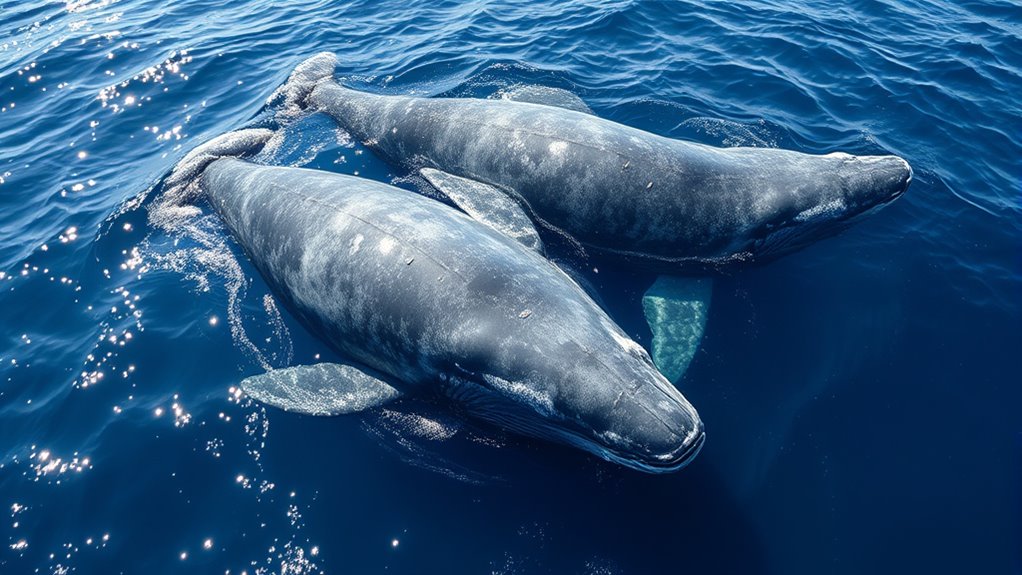
Human activities have a profound and often devastating impact on whale health, especially for critically endangered species like the North Atlantic right whale. You might not realize how your actions contribute to their decline.
- Vessel strikes cause injuries, fatalities, and disorientation.
- Fishing gear entanglements lead to injuries, impaired movement, and drownings.
- Noise pollution from ships disrupts communication, navigation, and feeding.
- Environmental changes from pollution and climate change reduce prey availability and increase stress.
- The use of vetting products and practices can also influence the health of these whales by affecting their habitat quality.
These activities cause chronic injuries, weaken immune systems, and hinder reproduction. Many whales suffer long-term health issues, making recovery difficult. Despite conservation efforts, human interference remains the biggest threat, pushing these giants closer to extinction. Your awareness and action are crucial to reduce these impacts and help protect their fragile populations.
Why Saving These Giants Matters for Our Oceans
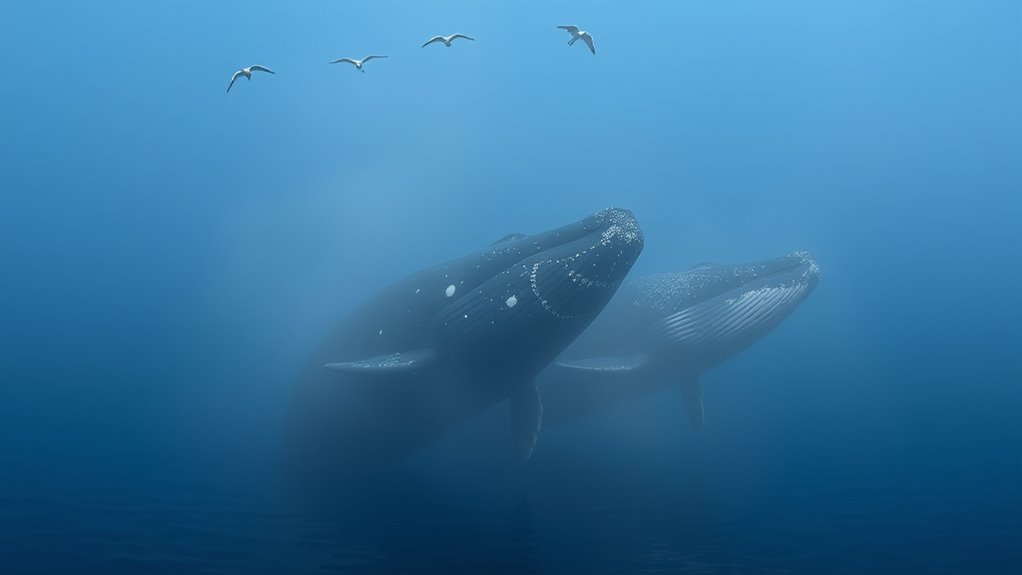
Saving North Atlantic right whales is essential because their health directly reflects the overall well-being of our oceans. These giants play a critical role in maintaining marine ecosystem balance and nutrient cycling. Their presence indicates healthy prey populations and stable habitats, which support countless other species. Protecting them helps preserve biodiversity and resilience against climate change impacts. As keystone species, their decline signals broader ecological issues that could cascade through the marine food web. Their survival also fosters ocean health awareness, encouraging sustainable practices. Additionally, understanding marine ecosystem dynamics is crucial for effective conservation strategies. Furthermore, conserving these whales demonstrates our commitment to safeguarding endangered species and restoring natural ocean processes. Their recovery would symbolize hope and a step toward healthier, more balanced marine environments for future generations. Recognizing the importance of air quality and pollution control in marine areas can further aid in their preservation.
Frequently Asked Questions
What Specific Policies Are Most Effective in Reducing Vessel Strikes?
A stitch in time saves nine. You can reduce vessel strikes by enforcing strict vessel speed limits in whale habitats, especially during peak calving seasons. Implementing dynamic management zones that adjust based on whale presence also helps. Real-time monitoring systems and mandatory reporting of whale sightings can alert mariners promptly. These policies, combined with public awareness campaigns, make a tangible difference in protecting these vulnerable giants from deadly collisions.
How Do Climate Change and Prey Availability Affect Whale Health?
Climate change alters ocean temperatures and currents, disrupting prey distribution like krill and plankton, which are essential for whale nutrition. When prey becomes scarce or shifts location, whales struggle to find enough food, leading to malnutrition, stress, and weakened immune systems. This health decline hampers reproduction and makes whales more vulnerable to threats like disease and human impacts, ultimately hindering their recovery and increasing their risk of extinction.
What Role Do Local Communities Play in Whale Conservation Efforts?
You play a crucial role in whale conservation by staying informed and supporting responsible practices. Avoiding vessel speeds in whale habitats, reducing fishing gear entanglements, and participating in local awareness campaigns help protect these whales. Your actions can influence policies and encourage sustainable fishing and boating behaviors, making a real difference. Community efforts, combined with advocacy and education, are essential in ensuring the survival and recovery of North Atlantic right whales.
Are There Successful Examples of Whale Population Recovery Elsewhere?
Like tending a delicate garden, successful whale recovery stories show that consistent, targeted efforts can yield results. For example, the North Pacific gray whale population rebounded after strict fishing regulations and habitat protections. You can learn from these successes by supporting policies that reduce bycatch, limit vessel speeds, and protect critical habitats. Your actions and advocacy can help turn the tide, giving these majestic creatures a fighting chance to thrive again.
How Can Technology Further Improve Monitoring and Protection Measures?
You can use advanced technology like drones, acoustic sensors, and satellite tracking to enhance monitoring and protection. Drones provide real-time visual data, helping spot whales and entanglements early. Acoustic sensors detect whale calls, enabling continuous tracking even in poor visibility. Satellite tags monitor movement patterns and habitat use, informing better management. Combining these tools allows you to respond quickly, reduce threats, and improve conservation efforts for the whales’ recovery.
Conclusion
You can’t ignore the fact that North Atlantic right whales are down to fewer than 350 individuals. Their decline impacts entire marine ecosystems, and saving them is vital for ocean health. Every effort counts—like reducing vessel speeds or preventing entanglements—because even saving one whale helps. Remember, these giants have been around for centuries, and it’s up to us to make sure they don’t disappear forever. Your actions can make a real difference in keeping these majestic creatures alive.







